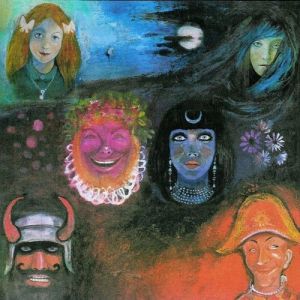- King Crimson’s second studio album debuts on the site with outstanding Double Plus (A++) sound or BETTER on both sides
- This pressing is Big and Tubey, with clear, breathy vocals, especially critical to the success of the a capella opening track, “Peace – A Beginning”
- This lovely original Island Pink Label British Import LP has a beautiful textured cover and plays as quiet as we can find them, Mint Minus to Mint Minus Minus throughout
- 4 1/2 stars: “The record…, however, has made an impressive show of transmuting material that worked on stage (“Mars” aka “The Devil’s Triangle”) into viable studio creations, and “Cadence and Cascade” may be the prettiest song the group ever cut.”
If you love the sound of a vintage All Tube recording of the mellotron — whether by Led Zeppelin or The Moody Blues — you will find that Robin Thompson has got hold of a very good sounding one here. Thompson is of course the engineer for the first King Crimson album, so his recording skills as regards the instrument are well established.
Note that the British Island pressings for this album as well as the first are by far the best sounding, assuming you have a good one. What is interesting about early Island LPs is just how bad some of them are. And let me tell you, we’ve paid the price in time and money to find out just how bad some Island Pink Labels can sound.
The bad ones of course never qualified to be Hot Stampers and were never offered for sale. As luck would have it the collectors of the world were more than happy to take them off our hands. They wanted the “right” label; they obviously were not looking for the best sound.
Click on the Pink Label link above to read more about some lessons we learned.
What the best sides of this 1970 Prog Rock album have to offer is not hard to hear:
- he biggest, most immediate staging in the largest acoustic space
- The most Tubey Magic, without which you have almost nothing. CDs give you clean and clear. Only the best vintage vinyl pressings offer the kind of Tubey Magic that was on the tapes in 1970
- Tight, note-like, rich, full-bodied bass, with the correct amount of weight down low
- Natural tonality in the midrange — with all the instruments (and effects!) having the correct timbre
- Transparency and resolution, critical to hearing into the three-dimensional studio space
- No doubt there’s more but we hope that should do for now. Playing the record is, of course, the only way to hear all of the above
Size and Space
Some copies of the album just sound small — they don’t extend all the way to the outside edges of the speakers, and they don’t seem to take up all the space from the floor to the ceiling. In addition, the sound can often be recessed, with a lack of presence and immediacy in the center of the soundfield.
Other copies — my notes for these copies often read “BIG and BOLD” — create a huge soundfield, with the music positively jumping out of the speakers. They’re not brighter, they’re not more aggressive, they’re not hyped-up in any way, they’re just bigger and clearer.
We often have to go back and downgrade the copies that we were initially impressed with in light of such a standout pressing. Who knew the recording could be that huge, spacious and three dimensional? We sure didn’t, not until we played the copy that had those qualities, and that copy might have been number 8 or 9 in the rotation.
Think about it: if you had only seven copies, you might not have ever gotten to hear a copy that sounded that open and clear. And how many even dedicated audiophiles would have more than one of two clean British early copies with which to do a shootout? These records are expensive and hard to come by in good shape. Believe us, we know whereof we speak when it comes to getting hold of British pressings of Classic Rock albums.
One further point needs to be made: most of the time these very special pressings just plain rock harder. When you hear a copy do what this copy can, it’s an entirely different – and dare I say unforgettable — listening experience.
AMG 4 1/2-Star Review
King Crimson opened 1970 scarcely in existence as a band, having lost two key members (Ian McDonald and Michael Giles), with a third (Greg Lake) about to leave. Their second album — largely composed of Robert Fripp’s songwriting and material salvaged from their stage repertory (“Pictures of a City” and “The Devil’s Triangle”) — is actually better produced and better sounding than their first.
Surprisingly, Fripp’s guitar is not the dominant instrument here: The Mellotron, taken over by Fripp after McDonald’s departure — and played even better than before — still remains the band’s signature. The record doesn’t tread enough new ground to precisely rival In the Court of the Crimson King.
Fripp, however, has made an impressive show of transmuting material that worked on stage (“Mars” aka “The Devil’s Triangle”) into viable studio creations, and “Cadence and Cascade” may be the prettiest song the group ever cut. “The Devil’s Triangle,” which is essentially an unauthorized adaptation of “Mars, Bringer of War” from Gustav Holst’s The Planets, was later used in an eerie Bermuda Triangle documentary of the same name.

